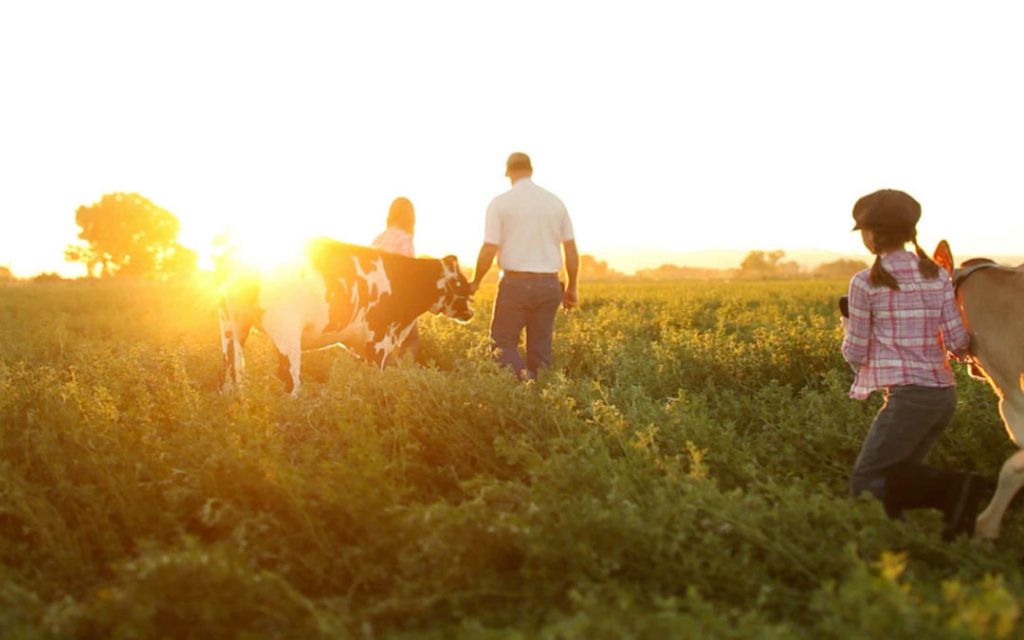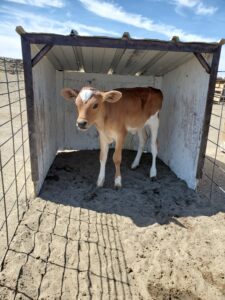For decades, dairy farmers and their families have been responsible stewards of the land—caring for their farms, their cows, and their communities from a nutritional and sustainable outlook. On average, a dairy farmer will work 12 to 14-hour days year-round. To understand the truth about land, crop, and livestock management practices, dairy farmers encourage a visit to their farms to learn the facts behind their farming practices.
Dairy farmers around the country have strong and documented commitments to animal welfare, and they make animal care their top priority. They wholeheartedly believe that animal abuse should never be tolerated. What you might not know is that they demonstrate their pledge to raising and caring for their animals humanely and ethically through their voluntary participation in an animal care program called the National Dairy Farmers Assuring Responsible Management program.
Our farms are family farms. Nearly 97 percent of dairy farms are family-owned. Nevada dairy farms are no different. With the community’s health in mind, dairy farmers stay connected to the earth. They know if they care for their cows, their cows will care for them by producing a nutrient-rich product for the community.
Why Calves Are Separated From Cows
Calves are removed from the cows when they are young. When cows get startled, they can jump and land on their calves, crushing them. It is for the calves’ safety that they are moved to a hutch. Adult cows weigh more than 1,000 pounds and could unknowingly harm baby calves. Humans care for their newborn babies in a similar way, by placing them in a bassinet rather than a crib because the smaller environment is safer for newborns. To provide calves with the best care, farmers feed them milk by hand and have veterinarians and nutritionists monitoring their diet and feed. They provide heaters and coats for them in the winter and misters and fans in the warmer weather to keep them comfortable.
Why Cows Drink Lots of Water
Like people, domestic, and wild animals, cows drink water for optimal daily functioning. Water is necessary to keep hydrated, to lubricate the joints, and carry nutrients to cells for metabolic processes to occur within the body. The recommended water intake for adult males and females is about 2.1 to 3.7 L/d, or approximately half a gallon. However, an average adult cow weighs around 1,600 pounds, thus having higher water requirements compared to humans.
The Undeniable Benefits of Dairy
Many studies have shown the numerous health benefits of dairy products. An 8-ounce glass of cow’s milk contains about 85 percent water, plus it’s rich in nine essential nutrients (calcium, protein, vitamin D, vitamin A, vitamins B2, B3, B5, B12, and phosphorous). Collectively, these nutrients have been shown to maintain strong bones and teeth, help build and repair muscle tissue, support metabolism, and promote healthy skin and eye health. Calcium is a vital electrolyte required for many body functions. It is critical for muscle contraction, blood clotting, nerve impulse and transmission, regulating heartbeat and fluid balance within the cells. Milk is an excellent source of calcium providing 300 mg per 8 ounces (and 6 ounces of plain low-fat yogurt provides over 400 mg per serving!). Calcium is a mineral found in a variety of foods; although, calcium absorption from milk is greater than from some non-dairy foods that contain smaller amounts of calcium. For example, only 5 percent of the calcium in spinach is absorbed and usable by the body, while 28 percent of the calcium in milk is absorbed.
The Truth About Dairy Farmers and Sustainability
Did you know that cow manure is a natural fertilizer? The fertilizer provides the nutrients necessary to grow plant crops. In addition, farmers recycle water three to five times to clean barns and irrigate crops to feed their cows. Some farmers even use an anaerobic digester system which captures the methane gas released by their cows’ manure and transform that gas into electricity. When discussing sustainability and Greenhouse Gas Emissions on the environment, reputable information providing data on all resources contributing to carbon footprint should be outlined to understand the whole picture, not just isolating topics such as the dairy industry. The largest source of Greenhouse Gas Emissions in the United States is from burning fossil fuels for electricity, heat, and transportation. The comfortable cars we drive, planes we fly in, and the electricity we use to keep cool and warm are among the largest resources used in the United States. Agriculture as a whole (which includes crops and livestock) make up about 9 percent of total Greenhouse Gas Emissions in the United States compared to transportation at 29 percent, electricity at 28 percent, and industry sector production contributing 22 percent. To appreciate how agriculture fits into that equation, dairy agriculture alone contributes about 2 percent of total Greenhouse Gas Emissions. Since 2007, a gallon of milk uses 90 percent less land and 65 percent less water with a 63 percent smaller carbon footprint than in 1944. This is attributed to continuous improvements made by dairy farmers in their cows’ health and nutrition, comfort, and breeding.
A Balanced Diet: Dairy and Plants
When choosing what to eat to maintain a healthy diet, why not choose both plants and dairy? A plant-focused diet doesn’t mean animal products shouldn’t be included, it’s a term meant to encourage increasing foods like fruits and vegetables in your diet. Every food group offers different nutrients and benefits, so having a varied and balanced diet is important to stay healthy. Vegetarians are also encouraged to incorporate key dairy elements to have healthy eating patterns. The Dietary Guidelines for Americans (DGA) recommend animal products in as much as three daily servings of dairy for those 9 years old and older, as well as other animal and plant sources of protein. Research suggests that more than 80 percent of the population does not meet daily recommendations for dairy and for vegetables. Instead of choosing between food groups, it’s encouraged that people see food groups as a “plus.” Eat plants and animal products, drink milk and eat whole grain cereal, and enjoy delicious steamed broccoli with cheese. Next time you’re conflicted on what to eat, talk to a registered dietitian, and always opt for a healthy balanced diet of both plant and animal products.
A sustainable farm and a healthy planet can go hand in hand. Dairy farmers constantly seek ways to improve how they produce milk and are committed to investing in innovative, sustainable and social efforts that make a difference for everyone. The goal is and has always been to provide nutritious, high-quality, affordable products for generations to come.



